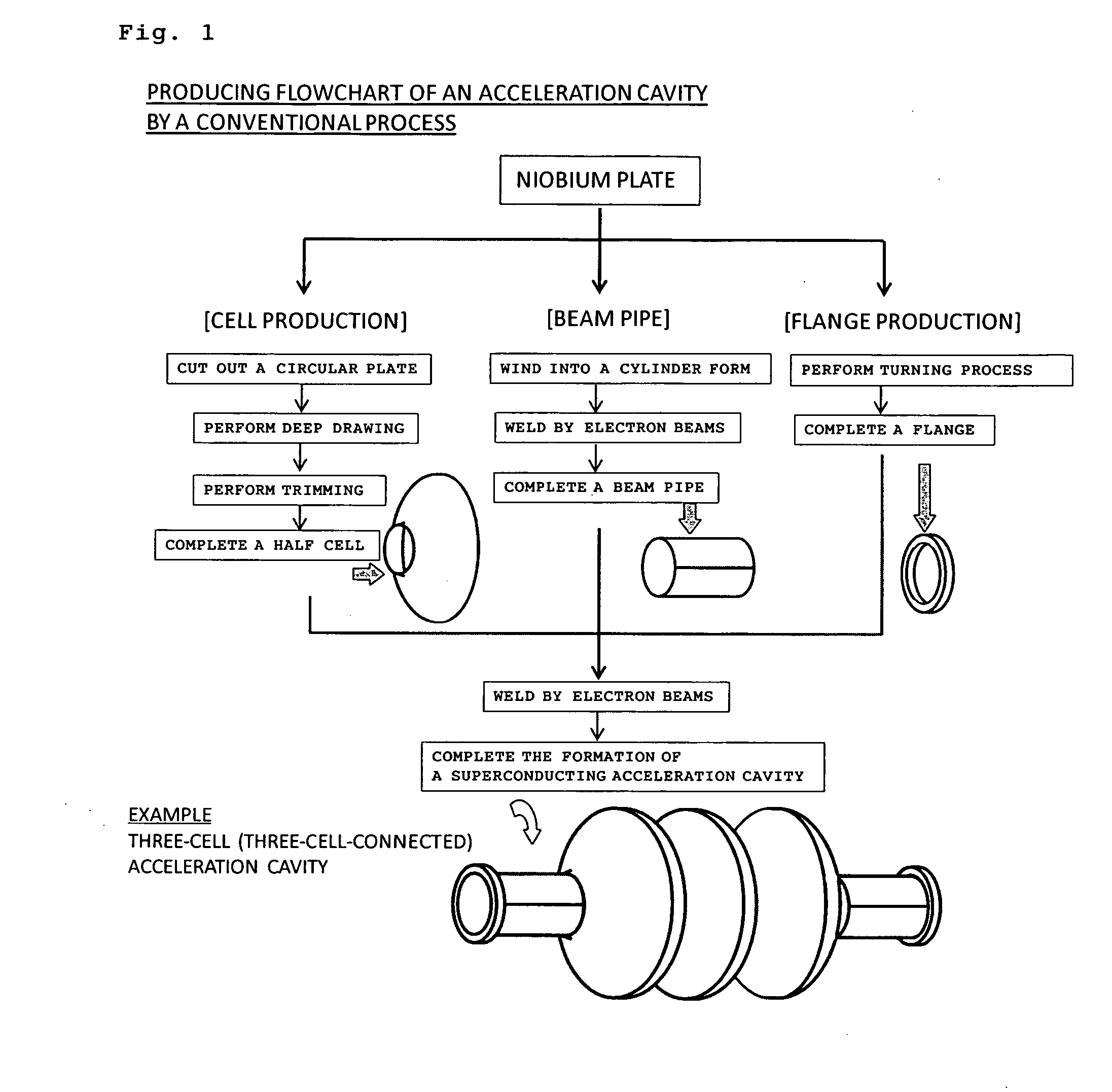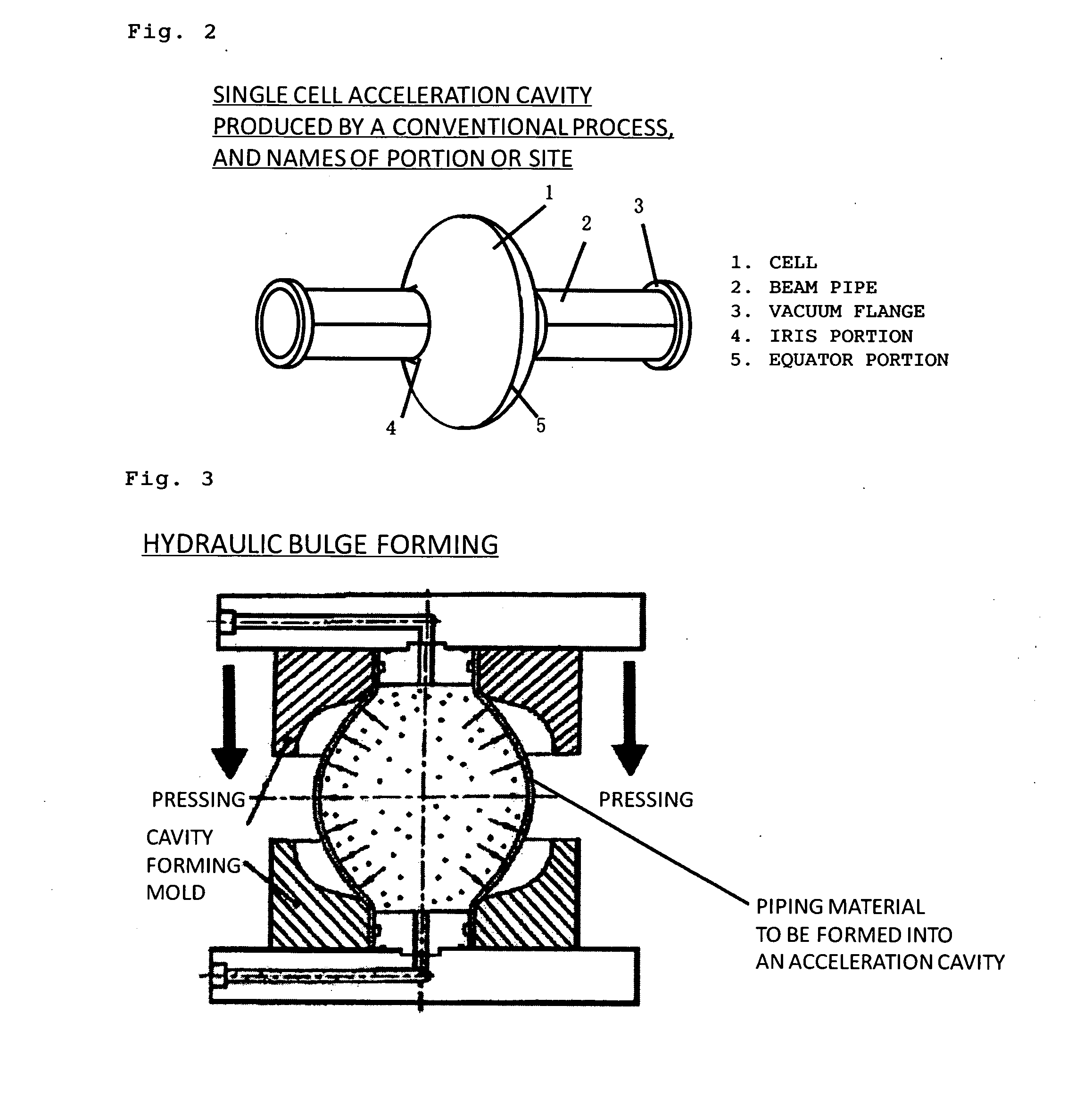This production process requires many working steps; thus, there exists a problem that costs for producing an acceleration cavity are inevitably increased up.
Furthermore, there exists a basic problem concerned with accelerating performances since
electron beam
welding is frequently used.
For example, when
welding defects are present, in particular, such defects are present in the
equator portion of a cavity, heat is often generated in welded sites.
However, in this process, no considerations are made for
pollution of the niobium surface generated at the time of removing the aluminum or the
alloy thereof with an acid or alkali, the purity of the formed niobium film, and stress to which the niobium thin film is subjected by the
pipe-enlarging working.
Thus, the process is a process which cannot be practically used at all.
Additionally, there are problems about costs such that an expensive large-sized vacuum film-forming apparatus for forming a niobium thin film and a
copper thin film is indispensable.
However, the acceleration cavity itself originally has a
spherical form, so that there is caused a problem about the evenness of the film thickness distribution of the niobium thin film obtained by
sputtering.
There is also caused a basic problem which affects performances, an example thereof being pinholes which are frequently encountered in the form of thin films.
Furthermore, as well as the process of JP-A-60-261202, there has not yet been overcome a problem of the
dissolution of niobium or the reduction in the thickness of niobium which follows chemical
polishing or
electropolishing of the inner surface of the cavity for the purpose of removing the surface
pollution of the inside of the cavity.
If the film thickness is made large under consideration of
dissolution loss of the niobium by the chemical
polishing or the
electropolishing, there are caused not only a problem about the time for forming the film but also a problem about the flatness of the surface.
Moreover, as well as the case of JP-A-60-261202, a large-sized and expensive vacuum film-forming apparatus is essential.
Accordingly, the production process of JP-A-1-231300 cannot be a stable process for producing a superconducting acceleration cavity since the process has many practical evil effects and cannot give a high accelerating
electric field from the viewpoint of performances.
However, supplementary experiments by the present inventors have demonstrated that the formation of a
diffusion layer of gold onto niobium is not observed at the above-mentioned temperature, and no effect of improving the adhesiveness is found out.
Furthermore, it is technically impossible for copper
electroplating or copper spraying to assure an even film thickness on the outer
peripheral surface of a superconducting acceleration cavity which is largely undulating in the shape thereof.
Thus, it is doubtful that the process will be realized.
Additionally, the process is involved in a serious problem that specific sites are cracked; thus, the process is not a useful process.
As a result, the following problems are not overcome: a problem that niobium material, which is expensive, is used in a
thick wall form; and a problem that a high electric resistance of niobium at normal temperature induces a local
heat generation phenomenon (called a hot spot), which hinders a highly accelerating
electric field at very low temperatures, to cause the quench of the superconductive state.
Niobium material essentially has these problems.
However, there remains a problem that after the end of the bulge forming, the copper piping material of the inner cylinder must be dissolved and removed with a
chemical agent for dissolving copper, for example,
nitric acid.
Additionally, the HIP bonding method itself requires an expensive and special apparatus and further the method is basically batch working.
Furthermore, the most serious problem when the HIP bonding method is applied to the production of the above-mentioned copper / niobium composite
pipe is that when the inner cylinder, the niobium
pipe and the outer cylinder are designed and formed in such a manner that the fitting crossing of the diameters can have a margin so as to attain the
insertion of each of the cylinders and the pipe with ease, the
bonding strength cannot be sufficiently kept.
Accordingly, apart from the case of forming a composite piping material for a superconducting acceleration cavity having a
short length in the axial direction, the HIP bonding is unsuitable for the process for producing a composite piping material for an ordinary
superconducting cavity having a total length of 1 m or more.
However, this process is too complicated.
Thus, apart from the case of carrying out
mass production of clad element pipes, the process is unsuitable for the aim of lowering costs.
 Login to View More
Login to View More 


